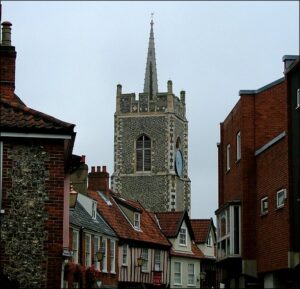
Image Source: Norfolk Churches
John Crawford Bell L.S.A. (1799 – 10 July 1877) [no evident relation], was a British orthodox surgeon and apothecary who converted to homeopathy and in 1853 was recorded as practicing as a surgeon at Princes Street, Norwich. By 1873, in addition his Princes Street practice, Bell was also listed at 93 High Street, Lowestoft, and at 2 Gaol Street, Great Yarmouth.
John Crawford Bell was born in Ipswich in 1799.
He received his License from the London Worshipful Society of Apothecaries in 1825.
In 1844 Bell, then practicing as surgeon and apothecary in Norwich, was declared bankrupt.
John Crawford Bell was married to Elizabeth from Colchester. She died before the 1861 census. Residing with the Bells in 1851 and again in 1861 was school mistress Elizabeth Strutt, also from Colchester.
In the 1875 Yearbook of Pharmacy, Crawford Bell was one of the testimonial providers in an advertisement for Ipswich and London-based Scrivener, Gill, and Company’s Amynterion Magnetic Curative Appliances. These electro-magnetic devices were licensed from Phillip William Seymour, Medical Electrician at Guy’s Hospital and, later, Onslow College, South Kensington, who introduced the concept in his 1873 book Magneticon. In his testimonial, Crawford Bell noted that one of the Amynterion wearable devices had enabled him to walk “with firmness and confidence” again after a period of debilitating muscular weakness.
Bell died in Norwich on 10 July, 1877 and was buried in the churchyard of St Saviour’s, Norwich. A memorial verse was written in his honour by Robert Abbott, of Malton, for the Swedenborgian Intellectual Repository of the New Church.
Of interest:
John Bell (4 December 1774 – 14 January 1849) [no evident relation] was a pharmacist and, in 1798, the founder of orthodox pharmaceutical firm John Bell and Co., 338 Oxford Street, London.
John Crawford Bell L.S.A. (1799 – 10 July 1877) L.S.A. London 1825, [no evident relation] was a British orthodox surgeon and apothecary who converted to homeopathy and practiced at Princes Street, Norwich, and at 93 High Street Lowestoft. A memorial verse was written in his honour by Robert Abbott, of Malton, for the Swedenborgian Intellectual Repository of the New Church.
William Bell M.D. L.R.C.S. (c.1804 – 14 December 1886) [no evident relation] was a British homeopath who took part in a Festival in aid of the London Homeopathic Hospital in 1853. Bell was surgeon to the Queen’s County Militia, Medical Officer to the County Tipperary Workhouse and Lunatic Asylum, and later was Medical Officer to the Norwich Homoeopathic Dispensary and Hospital, before setting up in private practice in London.
James Bachelder Bell M.D. (1813 – 1914) [no evident relation] was an American homeopathic physician.
(Thomas) Vernon Bell M.D. (1824 – 1905) [no evident relation] was a Scottish-born homeopathic physician, a member of the British Homeopathic Society, and a member of the Medical Council of the London Homeopathic Hospital, who practiced in London.
In August 1858 a letter to the Medical Times and Gazette suggested that Thomas Vernon Bell, recently graduated M.D. from the University of Edinburgh, was none other than William Bell, formerly of Norwich. The letter writer deduced that William Bell M.D. (Erlangen), as holder of a foreign qualification, had changed his name and identity in order to secure a British qualification and thus ensure his entry on the new medical register.
This accusation was baseless. William and Vernon Bell, both homeopaths, were two entirely separate individuals.
Joseph Bell F.R.C.S. (2 December 1837 – 4 October 1911) was a Scottish surgeon and lecturer at the medical school of the University of Edinburgh, where he was a friend and teacher of homeopath John Murray Moore. He was perhaps best known as being the basis for the character of Sherlock Holmes.


Leave A Comment